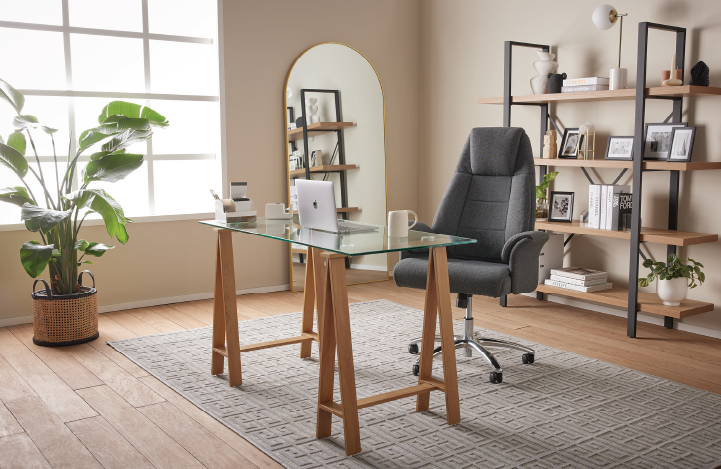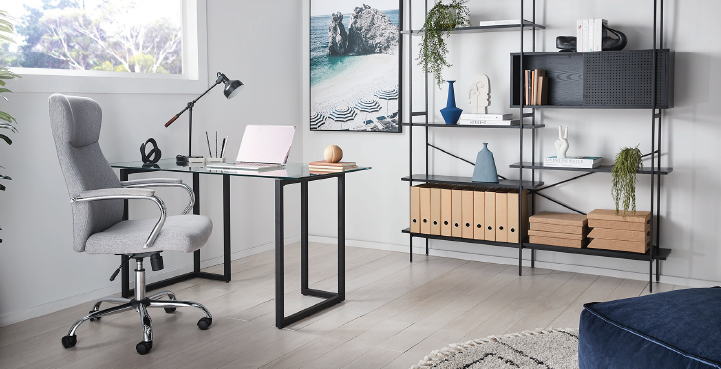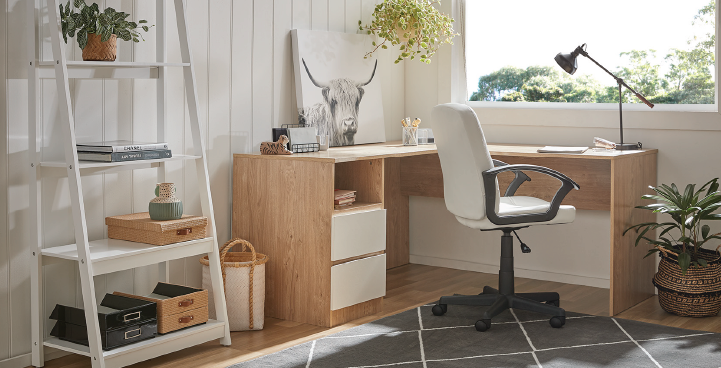Sign up to our newsletter and never miss out on the latest offers!
The Importance of Lumbar Support in your Office Chair
If you’re someone who spends a significant amount of time sitting at a desk, you’ll know how uncomfortable it can be without the right support. Sitting for long periods of time can put a strain on your lower back, leading to pain and discomfort.
This is where lumbar support comes in – it helps to maintain the natural curve of your spine, reducing the pressure on your lower back and providing the necessary support to keep you comfortable and productive throughout the day. Together we’ll explore why lumbar support is so important for office chairs, the benefits of using it, and how to choose the right lumbar support for your needs.
So, whether you’re a student, office worker, or someone who spends a lot of time sitting down, keep reading to find out how you can improve your comfort and health while working.
Image Features: Executive Chair, Waverley Trestle Desk, Bridge Bookcase, Mila Mirror, Ellery Rug
How Can I Make My Office Chair More Comfortable for Lower Back Pain?
Lower back pain is a common problem among people who sit for long hours in office chairs. Here are some tips on how to make your office chair more comfortable for lower back pain.
- Adjust the chair height: Make sure your chair is adjusted to the right height so that your feet are flat on the floor and your knees are at a 90-degree angle. This will help to maintain the natural curve of your spine.
- Use a lumbar support cushion: A lumbar support cushion can provide additional support to your lower back, reducing pressure and discomfort. Make sure the cushion is positioned properly, between your lower back and the backrest of the chair.
- Adjust the backrest angle: Adjust the angle of the backrest to support your lower back. Tilt the backrest slightly backward to provide more support to your lower back.
- Use a footrest: If your feet do not reach the floor comfortably, use a footrest to elevate your feet. This will help to reduce pressure on your lower back.
- Take breaks: It’s important to take regular breaks and stand up from your chair to stretch and move around. This will help to prevent stiffness and promote good blood flow.
- Consider an ergonomic chair: An ergonomic chair is designed to provide maximum support to the back and reduce pressure on the lower back. Look for a chair with adjustable lumbar support and other ergonomic features.
By following these tips, you can make your office chair more comfortable for lower back pain and reduce discomfort while working. If your lower back pain persists, consider consulting a healthcare professional for further advice.
Image Features: Oxford Office Chair, Lorne Desk, Nicholls Bookcase, European Getaway Framed Wall Art
Neck & Back Support for Office Chairs
In addition to the tips mentioned earlier, here are some additional things you can do to provide better back and neck support for your office chair:
- Use a headrest: A headrest can help to support your neck and prevent neck strain. Look for an office chair with an adjustable headrest or use a separate headrest attachment.
- Adjust the armrests: The armrests should be adjusted to the correct height so that your arms are at a comfortable angle and your shoulders are relaxed. This can help to reduce tension in your neck and upper back.
- Consider a standing desk: Sitting for long periods of time can put a strain on your back and neck. Consider using a standing desk or a desk that can be adjusted to a standing position to reduce pressure on your spine.
- Stretch and exercise regularly: Regular stretching and exercise can help to improve your posture, strengthen your back and neck muscles, and reduce the risk of pain and discomfort. Consider incorporating exercises such as yoga or Pilates into your routine.
- Use a posture corrector: A posture corrector can help to remind you to sit up straight and maintain good posture while working. Look for a comfortable, adjustable posture corrector that can be worn during the day.
Image Features: Monash Office Chair, Cody Corner Desk, Lean 5 Shelf Bookcase, Scottish Cow Wall
The Problem with Poor Back Support
Poor back support in office chairs can cause a number of problems, including:
- Lower back pain: Without proper support, the lower back can become strained and painful, leading to discomfort and decreased productivity.
- Poor posture: Sitting in an office chair without adequate support can cause you to slouch or hunch forward, leading to poor posture and increased strain on your back and neck.
- Neck and shoulder pain: Poor back support can cause tension in the neck and shoulders, leading to pain and discomfort.
- Fatigue: Sitting in a chair that doesn’t provide proper support can be tiring, leading to fatigue and decreased concentration.
- Decreased productivity: If you’re uncomfortable in your office chair, it can be difficult to focus on your work, leading to decreased productivity.
- Increased risk of injury: Prolonged sitting without proper back support can increase the risk of injury to the back and neck.
By addressing poor back support in office chairs, you can reduce the risk of these problems and improve your overall comfort and productivity while working.








